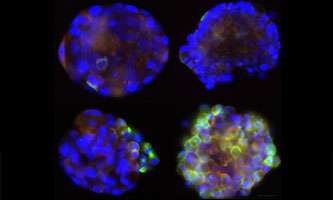Better understanding of how prostate cancer spreads around the body

Scientists have taken a major leap forward in being able to fully understand how prostate cancer cells acquire their ability to spread from the initial tumour to other areas of the body.
The Nottingham Trent University study is significant because metastasis – when cells begin to invade other sites such as the bone or brain – is responsible for the vast majority of prostate cancer-related deaths.
For the first time, a team at the university has been able to generate a panel of prostate cancer cells in the laboratory which spontaneously undergo a process thought to be involved in the spread of disease.
The work is expected to provide vital insight into the biology and spread of aggressive prostate cancers and help to improve the management, treatment and survival of patients with therapy-resistant disease.
Cells can acquire the invasive and migratory properties needed for metastasis by reactivating a programme called 'epithelial-to-mesenchymal transition' (EMT).
This is when epithelial cells which don't move and are tightly joined, undergo a change to become mesenchymal, where they lose their tight cell connections, change shape and gain the ability to migrate and invade surrounding tissues and blood vessels.
Although important, the process via which this happens in the body is poorly understood. A main limitation of prostate cancer research has been the lack of available cells which come from a primary tumour in the prostate and can be grown in the laboratory.
In the past, the most commonly-studied prostate cancer cells have been those which are generated from disease which has already spread from the prostate to other sites, such as the bone or brain.
But now scientists will be able to study the cells before this process occurs – getting a vital glimpse into cancer progression and metastasis at the earliest possible stage.
The researchers, based in the university's John van Geest Cancer Research Centre, were able to develop new and unique sub-populations of cells from a primary prostate cancer tumour cell line – and noticed that some of the cells spontaneously took on the features of those which can move to other tissues.
"Prostate cancer is the most common male cancer in Europe and 90% of cancer-related deaths are due to disease which is resistant to therapy and which has spread to other parts of the body," said Dr David Boocock, a scientist in Nottingham Trent University's John van Geest Cancer Research Centre.
He said: "Cancer cells acquire the capacity to move from the primary tumour to other sites by activating biological processes which allow them to survive the journey and establish themselves in their new 'home'.
"It is clear that understanding these processes is crucial if we are to reduce the number of prostate cancer-related deaths."
Professor Graham Pockley, the Director of the university's John van Geest Cancer Research Centre, added: "This work provides a novel and important platform for future studies that will help us to predict prostate cancer metastasis and better understand cancer progression.
"As such, it could also be crucial in providing valuable insight into potential new therapies and approaches for the treatment and management of prostate cancer."
The work is reported in Nature Publishing Group journal Scientific Reports.
More information: Naomi Harner-Foreman et al. A novel spontaneous model of epithelial-mesenchymal transition (EMT) using a primary prostate cancer derived cell line demonstrating distinct stem-like characteristics, Scientific Reports (2017). DOI: 10.1038/srep40633














